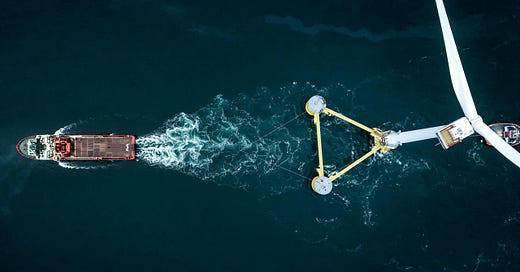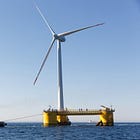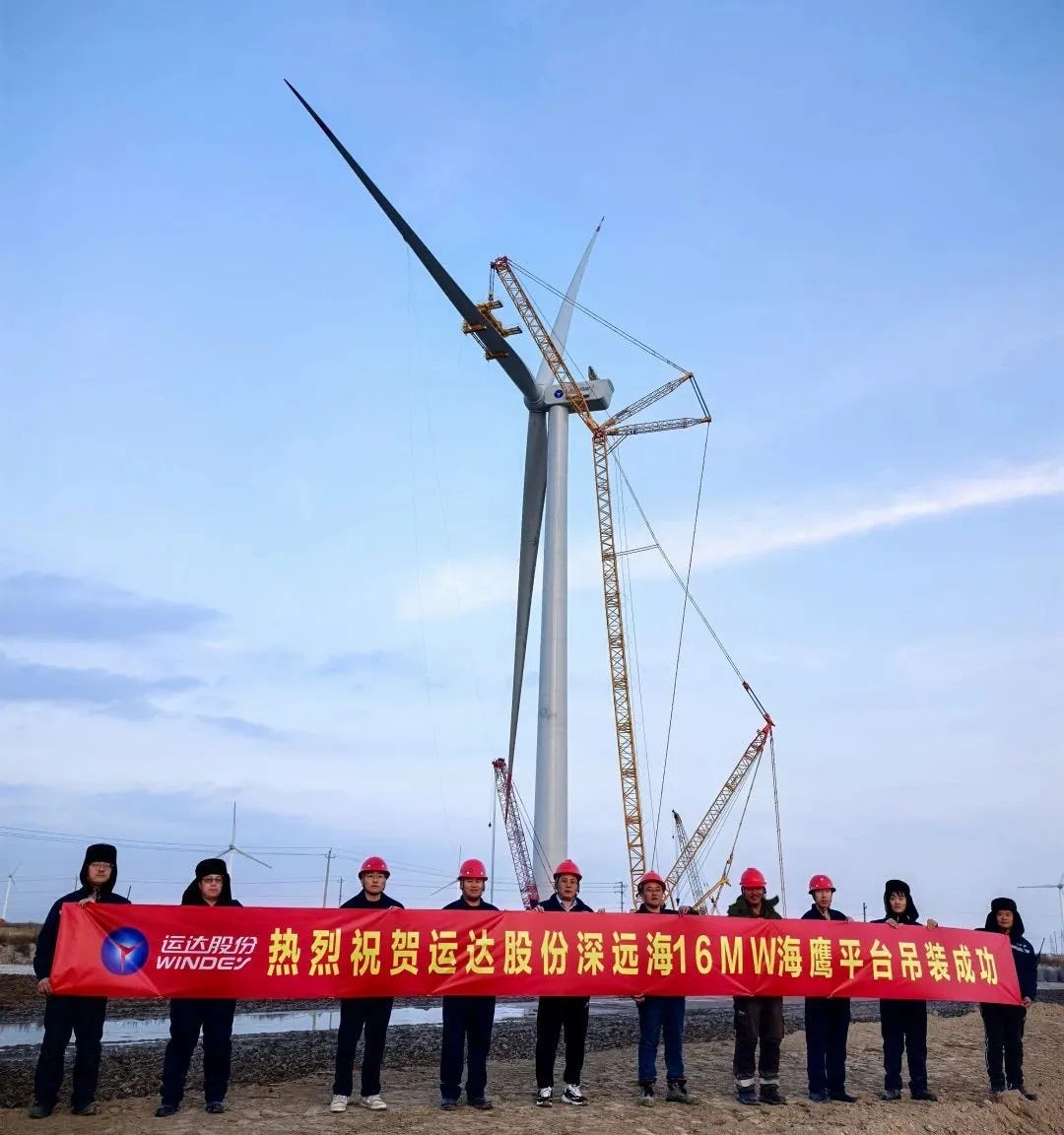Windletter #99 - The era of large-scale floating wind farms
Also: Windey unveils a 16 MW wind turbine, bird detection systems, Iceland's first commercial wind farm, and more.
Hello everyone and welcome to a new issue of Windletter. I'm Sergio Fernández Munguía (@Sergio_FerMun) and here we discuss the latest news in the wind power sector from a different perspective. If you enjoy the newsletter and are not subscribed, you can do so here.
Windletter is sponsored by:
🔹 Tetrace. Specialized services in operation and maintenance, engineering, supervision, inspection, technical assistance, and distribution of spare parts in the wind sector. More information here.
🔹 RenerCycle. Development and commercialization of solutions and specialized services in the circular economy for renewable energies, including comprehensive dismantling of wind farms and waste management, refurbishment and sale of components and wind turbines, management and recycling of blades and others. More information here.
Windletter está disponible en español aquí
The most-read content from the latest edition includes: Kiko Maza's article revisiting testing centers, the article in the Chinese press about broken blades, and Søren Lassen's post from Wood Mackenzie about European offshore auctions and how governments are responding.
Additionally, this week we published an article by Alberto Quintana Infante, Head of the Wind Resource Area at Hanwha Energy Corporation Europe, which provides valuable insights into wind resource analysis and understanding.
Don't miss it, and subscribe so you don't miss the second part 🙂
Now, let’s dive into this week’s news.
🌊 The era of large-scale floating wind farms
Although floating wind energy is currently in vogue, the reality is that there are still only a handful of operational projects worldwide, and none of them could be considered large-scale or commercial-scale projects—at least not when compared to the capacities typically seen in offshore wind.
According to data from RenewableUK in a report published in October 2024, there are currently 15 operational floating wind projects across seven countries, with a total capacity of 245 MW.
Norway leads the ranking with 94 MW of installed capacity (88 MW of which belong to Hywind Tampen) across three sites, followed by the UK with 78 MW installed in two projects (Hywind Scotland and Kincardine) and China with 40 MW across five projects. Portugal also features with the 25 MW from Windfloat Atlantic. The remaining megawatts, unless I’ve missed any, correspond to small pilot projects.
Additionally, four projects totaling 102 MW are currently under construction, at least two of which are in France: Eolmed (30 MW) and Provence Grand Large (25.2 MW).
As can be seen, all of these are small-scale parks that correspond to pilot plants or pre-commercial projects.
However, we are getting closer to the first large-scale parks. According to the same report, 7.3 GW of floating wind already have permits or are in the pre-construction phase, 21.6 GW are in the planning system, and an impressive 184 GW are in the early development phase.
In recent times, there has been significant activity around auctions that are beginning to award floating offshore wind projects for the first time. The most notable recent awards, which hint at the arrival of the first commercial-scale parks, have taken place in France, the UK, and South Korea.
France
France has awarded a total of 750 MW of floating wind capacity—250 MW in May 2024 (AO5 auction) and two additional 250 MW blocks in December 2024 (AO6 auction). The awarded projects are as follows:
Pennavel
250 MW
Owned 50% by Elicio and BayWa
Narbonaise
250 MW
Owned 50% by Ocean Winds and Banque des Territoires
Golfe de Fos
250 MW
Owned 50% by EDF and Maple Power
Additionally, France plans to award 2.9 GW of offshore wind capacity in October 2025, a significant portion of which will be floating wind.
United Kingdom
The UK awarded 400 MW of floating wind in the AR6 auction in September 2024, all of which correspond to a single project:
Green Volt Offshore Windfarm
Up to 35 turbines with a capacity of up to 560 MW (although the auction awarded 400 MW)
Owned 50% by Flotation Energy and Vårgrønn
This is a project that already has all the necessary permits.
South Korea
South Korea held an offshore auction in which 1,886 MW of offshore wind capacity were awarded, of which 750 MW correspond to a single floating wind project. This is the largest floating wind project in the world with an awarded tariff and the first commercial floating wind project outside Europe:
Firefly
750 MW
Owned 100% by Equinor
Given the timelines typical of offshore projects, none of these parks are expected to begin commercial operation before 2029, so we will still have to wait to see them in action.
In any case, one of the most challenging parts of the development process—securing a competitive tariff—has already been accomplished. From here, it’s all about continuing to refine a technology that we know faces many technical challenges.
🏗️ Windey unveils a 16 MW floating wind turbine and plans a 16 MW onshore model
Windey has installed a 16 MW wind turbine on a floating offshore wind platform, according to a LinkedIn post and coverage by Windpower Monthly.
While the announcement is somewhat unclear, Windey states that the platform, named Seahawk, has been tested for over a year and features doubly fed induction generator (DFIG) technology. The accompanying photo doesn’t make it clear which platform it corresponds to, but it doesn’t appear to be the floating one despite being included in the post.
Interestingly, the nominal power of this turbine is identical to that of Windey’s onshore 16 MW model, which was recently announced as a development and research project. This would make it the most powerful onshore wind turbine in the world, surpassing Sany’s 15 MW model.
According to Windpower Monthly, Windey is also working on offshore models with capacities of 18 MW and 25 MW.
🦅 How bird detection systems work: the example of Masdar and IdentiFlight
Bird detection systems are increasingly common in newly built wind farms. Environmental impact assessments often require these devices to be installed on turbines.
The ultimate goal is to minimize bird mortality, especially in areas where protected species are present. Depending on the bird detected and its trajectory, the system sends stop commands to the corresponding wind turbine.
Of course, the system must also be precise and avoid false positives to minimize its impact on electricity generation.
These detection systems are becoming increasingly sophisticated, featuring dozens of cameras installed on turbines and additional poles throughout the wind farm.
Masdar has published an interesting video showcasing the operation of IdentiFlight's system at the Zarafshan wind farm (Uzbekistan), a 500 MW project with Goldwind turbines.
🏭 First nacelle manufactured by Goldwind in Brazil
A few months ago, we discussed that the Chinese manufacturer Goldwind had acquired a General Electric nacelle factory in Camaçari (Brazil), marking its first factory outside its home country.
Well, after several months, Goldwind has now completed its first nacelle produced at this new plant.
Goldwind is already leveraging this factory in the local market, recently announcing an order for 17 GWH182-6.2MW turbines for SPIC Brazil, the Brazilian subsidiary of Chinese energy giant SPIC. Everything stays in the family.
Let’s remember that the Brazilian market is significant, being the third-largest in the world by volume in 2023, after China and the United States. So, it makes sense that Goldwind has invested in it to seek sales outside China.
🌋 Enercon to supply its E-138 EP3 to Iceland's first wind farm
Enercon and Landsvirkjun, Iceland's public electric company, have signed a contract to construct the country’s first large-scale wind farm.
Enercon will supply 28 units of its E-138 EP3 turbine, each with a capacity of 4.26 MW and a hub height of 81 meters, for a total of 120 MW. The wind farm will be built in Búrfell, about 130 kilometers from Reykjavik. The first components will be delivered to the site in May 2026, and construction will begin in the second quarter of that year.
The history of wind power in Iceland is very short and recent. The country has only four installed wind turbines, all Enercon E44/900, for a total installed capacity of 3.8 MW. For the curious, you can find the location of these two wind farms:
Þykkvabæ (this park has unusual square-shaped foundations with what looks like a wooden platform).
It may seem surprising that Iceland has waited so long to build its first large wind farm, but the reality is that the country already has a nearly decarbonized electricity mix (and likely at a very low cost) thanks to hydropower and geothermal energy.
🇰🇿 Sany and Envision announce factories in Kazakhstan
I found it interesting that both Sany and Envision have announced wind turbine manufacturing plants in Kazakhstan.
On December 29, Sany held a groundbreaking ceremony for a new wind turbine manufacturing plant in the Jambyl region, where it plans to produce blades, nacelles, and towers.
Just a few days later, on January 2, Envision announced an agreement with Kazakhstan Utility Systems and Samruk Energy to collaborate on "design, manufacturing, and operation of smart wind turbines and energy storage systems."
Kazakhstan is a vast country with good wind generation potential. However, with a population of just 20 million, it seems unlikely to become a huge market for wind energy. According to thewindpower.net, the country had 1,500 MW installed at the end of 2023.
Given its geographical location, transporting large components from China might be challenging, which may have influenced the decision to open these factories.
🎥 Bungee jumping from an operating wind turbine
While browsing LinkedIn, I came across a video that truly left me speechless.
Beyond the fact that the jump isn’t for everyone (though I hope it was performed by professionals), I was particularly surprised that it was done with the turbine in operation.
What do you think?
Thank you very much for reading Windletter and many thanks to Tetrace and RenerCycle, our main sponsors, for making it possible. If you liked it:
Give it a ❤️
Share it on WhatsApp with this link
And if you feel like it, recommend Windletter to help me grow 🚀
See you next time!
Disclaimer: The opinions presented in Windletter are mine and do not necessarily reflect the views of my employer.













Fascinating, thank you Sergio - I'm a researcher and journalist, currently looking into topic of China-Brazil cooperation on renewables. Do you have an email I could get in touch with you on?
Usa will be zero for next 4 years